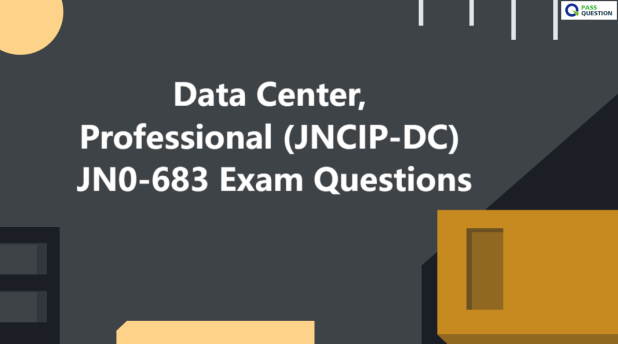
Data Center, Professional (JNCIP-DC)
To ensure your success in the latest Data Center, Professional (JNCIP-DC) JN0-683 exam, it's crucial to have access to the most reliable and up-to-date study materials. PassQuestion offers the newest Data Center, Professional (JNCIP-DC) JN0-683 Exam Questions tailored to provide comprehensive coverage of all exam topics. These practice questions enhance your understanding of data center technologies, helping you prepare effectively and boost your confidence for the exam. With PassQuestion Data Center, Professional (JNCIP-DC) JN0-683 Exam Questions, you'll be equipped with the best tools for passing the JNCIP-DC certification JN0-683 exam on your first attempt.

The Data Center track enables you to demonstrate competence with advanced data center technologies and related configuration and troubleshooting skills. JNCIP-DC, the professional-level certification in this track, is designed for experienced data center networking professionals with advanced knowledge of the Juniper Networks Junos software and data center devices. The written exam verifies your understanding of data center technologies, related platform configuration, and troubleshooting skills.
This track includes four certifications:
- JNCIA-DC: Data Center, Associate.
- JNCIS-DC: Data Center, Specialist.
- JNCIP-DC: Data Center, Professional.
- JNCIE-DC: Data Center, Expert.
Exam information
Exam Code: JN0-683
Prerequisite Certification: JNCIS-DC or JNCIS-ENT
Delivered by Pearson VUE
Exam Length: 90 minutes
Exam Type: 65 multiple-choice questions
Software Versions: Junos OS: 23.4
Juniper JN0-683 Exam Topics
Data Center Deployment and Management
Describe data center deployment concepts.
Zero-touch provisioning (ZTP)
Dynamic Host Configuration Protocol (DHCP)
Describe data center management concepts.
Monitoring
Analytics (telemetry)
Layer 3 Fabrics
Describe IP fabric concepts.
IP fabric architecture
IP fabric routing
IP fabric scaling
IP fabric Class of Service (RDMA/RoCE)
IP fabric best practices
Demonstrate knowledge of configuring, monitoring, or troubleshooting an IP fabric.
VXLAN
Describe VXLAN concepts.
VXLAN control planes
Data plane
Demonstrate knowledge of configuring, monitoring, or troubleshooting VXLAN.
EVPN-VXLAN Signaling
Describe EVPN concepts.
Route types
EVPN multicast
Multiprotocol BGP (MBGP)
EVPN architectures (CRB and ERB)
MAC learning
Symmetric routing
Demonstrate knowledge of configuring, monitoring, or troubleshooting EVPNs.
Data Center Interconnect
Describe Data Center Interconnect (DCI) concepts.
Interconnect network types
Layer 2 and Layer 3 stretch
Stitching
EVPN-signaled VXLAN for DCI
Demonstrate knowledge of configuring, monitoring, or troubleshooting DCI.
Data Center Multitenancy and Security
Describe single tenant and multitenant architectures.
Tenant traffic isolation (Layer 3 or Layer 2)
Multitenancy (for example, routing instances)
Describe data center security concepts.
Filter-based forwarding
Group-based policy (GBP)
View Online Data Center, Professional (JNCIP-DC) JN0-683 Free Questions
1. Which two statements are correct? (Choose two.)
A. Data center interconnect can only be a Layer 3 connection.
B. Data center interconnect can only be a Layer 2 connection.
C. Data center interconnect can be a Layer 2 or Layer 3 connection.
D. Data center interconnect is used to connect multiple data centers together.
Answer: C, D
2. What are two methods used to scale an IBGP IP Fabric? (Choose two.)
A. confederations
B. redundant trunk groups
C. route reflection
D. spanning tree
Answer: A, C
3. To provision a Juniper QFX Series switch using Zero Touch Provisioning, which three components are required? (Choose three.)
A. DHCP Server
B. a preconfigured device configuration file
C. a file server
D. multicast support
E. a DNS server
Answer: A, B, C
4. Which two statements are true with MC-LAG? (Choose two.)
A. MC-LAG uses Inter-Chassis Control Protocol (ICCP) to communicate with a remote end point.
B. MC-LAG uses Link Aggregation Control Protocol (LACP) to communicate with a peer device.
C. MC-LAG uses Link Aggregation Control Protocol (LACP) to communicate with a remote end point.
D. MC-LAG uses Inter-Chassis Control Protocol (ICCP) to communicate with a peer device.
Answer: C, D
5. What is the endpoint of a VXLAN tunnel?
A. DLCI
B. VTEP
C. LSR
D. VCF
Answer: B
6. Which two statements are true regarding IP fabrics? (Choose two.)
A. An IP fabric uses Spanning Tree Protocol to avoid loops.
B. An IP fabric uses routing protocols to avoid loops.
C. An IP fabric uses standby links for redundancy.
D. An IP fabric load balances across links for redundancy.
Answer: B, D
7. When QFX5100 series and EX4300 series are in a Virtual Chassis, which two statements are true? (Choose two.)
A. The Virtual Chassis stack scales down to the lowest maximum scaling number between members.
B. The Virtual Chassis stack scales up to the highest maximum scaling number between members.
C. The scale capacity of each switch is dependent on the model of the switch.
D. QFX5100 and EX4300 switches do not form a virtual chassis with each other by default.
Answer: A, D
8. Which two statements are true regarding EVPN Route Distinguishers? (Choose two.)
A. It can contain a two byte administration field and a four byte assigned number field.
B. It can contain a four byte administration field and a two byte assigned number field.
C. It can contain a six byte administration field and a two byte assigned number field.
D. It can contain a two byte administration field and a six byte assigned number field.
Answer: A, B
9. What are two primary uses for VXLAN? (Choose two.)
A. Create a Layer 2 overlay on a Layer 3 network.
B. Create a Layer 3 overlay on a Layer 2 network.
C. Provide data privacy and security in a datacenter.
D. Enable Layer 2 connectivity between remote hosts.
Answer: A, D
10. Which statement describes a Juniper Virtual Chassis Fabric?
A. two or more QFX Series or EX Series switches in a ring topology
B. two or more QFX Series or EX Series switches in a full mesh topology
C. two or more QFX Series or EX Series linked in a spine-leaf topology
D. two or more QFX Series or EX Series switches in a daisy-chain topology
Answer: C
Related Courses and Certification
Also Online IT Certification Courses & Online Technical Certificate Programs

